Ata-ul-Haye Nasir, Ahmadiyya Archive & Research Centre
Allah the Almighty sent Hazrat Mirza Ghulam Ahmadas of Qadian, who claimed to be the Promised Messiah and Mahdi. He claimed to be the metaphorical second coming of Jesusas of Nazareth and the divine guide, whose advent was foretold by the Holy Prophet Muhammadsa. Moreover, according to prophecies, he was granted the status of a prophet, but within the Quranic law.
In an era when people would assert that Allah did not speak to mankind anymore, Hazrat Ahmadas said that God had not ceased speaking to His servants. He claimed that God spoke with him and not only spoke, but did so bountifully. He told the world that he experienced many revelations, visions and dreams from Allah the Almighty, which included many glad tidings and prophecies about many incidents that were to happen. Those glad tidings related to his victory, his Jamaat’s progress and divine protection amid severe opposition.
On 17 September 1906, Allah the Almighty revealed to the Promised Messiahas:
بَارَكَ اللّٰهُ فِیْ اِلْهَامِكَ وَوَحْیِکَ وَرُؤْيَاكَ
“Allah has placed blessings in your inspiration, your revelation and your dreams.” (Tadhkirah [English], p. 918)
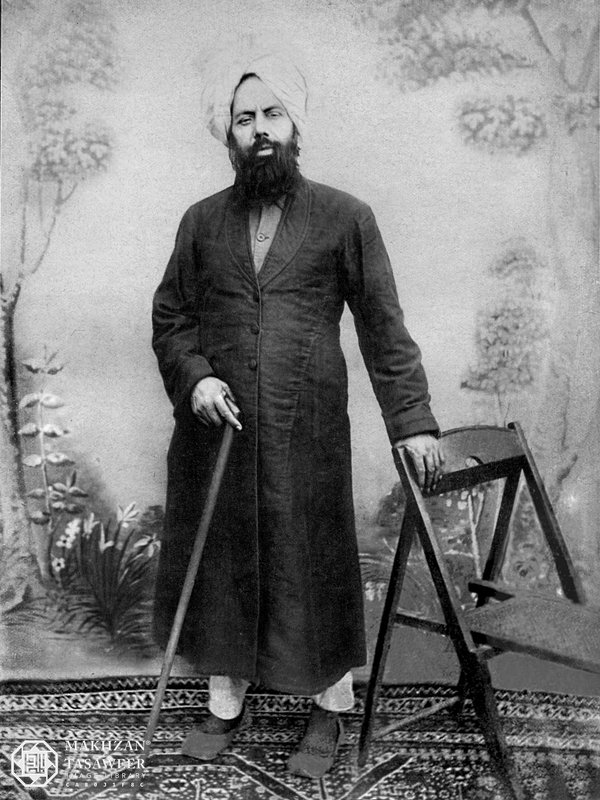
Revelations and divine visions since a young age
The Promised Messiahas had experienced divine visions and dreams since his early youth. He was also blessed to have seen the Holy Prophet, peace and blessings of Allah be upon him, in divine visions. (Tadhkirah [English], pp. 3-6)
This was a result of the Promised Messiah’sas strong connection and love with the Holy Prophetsa.
Revelation in regard to his father’s death
Prior to his father’s demise, the Promised Messiahas was foretold by Allah the Almighty in a dream that the time of his father’s death was near. He was in Lahore when he saw the dream, so he hastened back to Qadian. He found him ill, but did not expect that he would die the very next day. The next day, he received a revelation:
وَالسَّمَآءِ وَالطَّارِقِ
“We call to witness the heaven where all decrees originate and We call to witness the event which will happen after the setting of the sun.” (Tadhkirah [English], p. 30)
Through this revelation, he was made to understand that this revelation was by way of condolence on the part of Allah the Almighty and that the occurrence to which it related was that his father would die after sunset. Accordingly, his father died the same day after sunset.
When he received the revelation from Allah concerning the death of his father, he was naturally worried. Thereupon, he received the second revelation:
اَلَيْسَ اللّٰهُ بِكَافٍ عَبْدَهٗ
“Is not Allah sufficient for His servant?” (Tadhkirah [English], p. 31)
After this, he started receiving revelations in abundance. In regard to this, he states:
“On the one hand, there was his [Huzoor’s father] departure from this world, while on the other hand, I started experiencing a series of divine discourses with great intensity.” (Kitab-ul-Bariyyah [Baqiya Hashia], Ruhani Khazain, Vol. 13, p. 195)
During the days when he was writing Barahin-e-Ahmadiyya, he was bountifully blessed with divine words and many divine news were being manifested to him.
In March 1882, he received a revelation:
قُلْ اِنِّیْ اُمِرْتُ وَاَنَا اَوَّلُ الْمُؤْمِنِيْنَ
“Say: ‘I have been commissioned and I am the first of the believers.’” (Tadhkirah [English], p. 56)
How the Promised Messiahas would record his revelations and inform others of them
We find details of how the Promised Messiahas would record his revelations, visions and dreams and inform others about them in Hayat-e-Ahmad (Vol. 2, Part 1, pp. 87-89), and Tarikh-e-Ahmadiyyat (Vol. 1, pp. 193-194).
It was his routine that he would inform his close friends and guests who visited him about such divine information.
In Qadian, from the Hindus, he would narrate divine news and prophecies to Lala Malawamal, Lala Sharampat Rai and Bhai Kishan Singh etc., while from the Muslims, he would tell Mian Jan Muhammad Sahib (an imam of a mosque) and some other Muslims who would come to Qadian.
Moreover, he would also inform others through letters, including Lala Bhim Sin, Hafiz Hidayat Ali Sahib and some others who had good relations with Huzooras and his family.
When the Promised Messiahas started experiencing divine discourse abundantly, he employed a roznamcha nawees (Daily Diary Scribe) in 1880-81. In this regard, the Promised Messiahas states:
“A Pandit’s son, by the name of Sham Lal, who could write in both Devanagari and Persian, had been in my employment as a scribe of the daily diary. I used to make him write my revelations concerning the unseen matters in Devanagari and Persian before their fulfilment and then Sham Lal used to sign them.” (Barahin-e-Ahmadiyya, Part IV [English], p. 361)
This person did this work for quite a while, but when Pandit Lekh Ram visited Qadian, he influenced him to leave the job. Although he had to quit due to the religious influence of Lekh Ram, he used to come secretly for performing that task. Due to the fact that Huzoor’sas purpose for recording those revelations and living signs of Allah was to provide the final argument to all, he himself expelled him from the job. Huzooras then employed another Hindu Barahman, namely Kalia Bawa Das for this task.
Huzooras would not only ensure that those revelations and visions were recorded, but also continued to inform others regularly.
He would keep his close friends up to date through letters as well, in regard to his revelations and visions, especially to Mir Abbas Ali Sahib of Ludhiana. Whenever Huzooras would send a letter to anyone in regard to his revelations or visions, he would also send a copy to Mir Abbas Ali Sahib, who would then note down those revelations and visions in a register.
Notebook of revelations
Huzooras had a personal notebook, in which he would note down the revelations, visions and dreams.
Hazrat Mufti Muhammad Sadiqra stated:
“At night, the Promised Messiahas would always keep a notebook, pen and inkpot or a pencil near his bed, and upon receipt of any revelation, he would write it down on that notebook and would write a revelation on the same page many times, so there could not be any difficulty in correctly reading it in the morning because it would have been written during the dark at night.” (Zikr-e-Habib, p. 26)
Hazrat Musleh-e-Maudra states:
“Once the Promised Messiahas received the revelation:
اِنِّیْ مَعَ الْاَفْوَاجِ اٰتِيْكَ بَغْتَةً
“Meaning that, ‘I shall come to you suddenly with all My hosts’. [Tadhkirah (English), pp. 733-734]
“That same night, when the Promised Messiahas had this revelation, an angel came to me [in a dream] and said that the Promised Messiahas had this revelation tonight:
اِنِّیْ مَعَ الْاَفْوَاجِ اٰتِيْكَ بَغْتَةً
“In the morning, Mufti Muhammad Sadiq Sahib asked me to go inside and bring the latest revelations in writing, which had descended upon the Promised Messiahas. Mufti Sahib had assigned me this duty and I used to bring the latest revelations of the Promised Messiahas in writing and hand it over to Mufti Sahib so that he could publish them in the newspaper. That day, when the Promised Messiahas gave the revelations in writing, he forgot, in a hurry, to write the revelation:
اِنِّیْ مَعَ الْاَفْوَاجِ اٰتِيْكَ بَغْتَةً
“When I read those revelations, out of respect, I did not have the courage to say anything to the Promised Messiahas in regard to this. I also did not want to consider whatever I was told [by the angel] as wrong. In that situation, I would approach the door [to Huzoor’s room] but would then return. I repeated this many times, when eventually, I gathered some courage and said that last night, an angel told me that you had been revealed:
اِنِّیْ مَعَ الْاَفْوَاجِ اٰتِيْكَ بَغْتَةً
“But this was not mentioned in those revelations [given by Huzooras for publication].
“The Promised Messiahas stated, ‘This was revealed, but I forgot while writing [to give for publication].’
“Therefore, [when Huzooras] opened the notebook [of revelations, to confirm] that revelation was also present there. So, the Promised Messiahas wrote that revelation as well, for publication in the newspaper.” (Roya-o-Kashuf Syedna Mahmud, pp. 7-8)
Hazrat Musleh-e-Maudra further stated:
“It was 8 March 1907, when, at night, I was shown a notebook of revelations in a dream, about which someone said that it was the notebook of Hazrat Sahib’s revelations and it had written on it in a thick font:
عَسٰٓی اَنْ تَكْرَهُوْا شَيْئًا وَّهُوَ خَيْرٌ لَّكُمْ
“‘It may be that you dislike a thing while it is good for you.’ Then the scene changed and I saw there was a mosque and people had created disturbance against its custodian. […] Meanwhile a person of white complexion came, who told me that there were three sorts of people related to the mosque; firstly, those who only offered prayers and were also good; secondly, those who were administratively responsible for the mosque, and thirdly, the custodian. […]
“The next morning, I told this dream to my father [the Promised Messiahas]. Upon hearing this, he became engaged in thought and stated, ‘Seeing a mosque [in a dream] suggests a jamaat [congregation and community]; maybe some people of my Jamaat will oppose me. Let me write this dream.’ So, I narrated the dream and he wrote it down in his notebook. He wrote the date first and then wrote, ‘Mahmud’s dream’.” (Roya-o-Kashuf Syedna Mahmud, pp. 9-10)
In regard to the notebook of revelations, we now present an excerpt from Al Hakam (Urdu), which states:
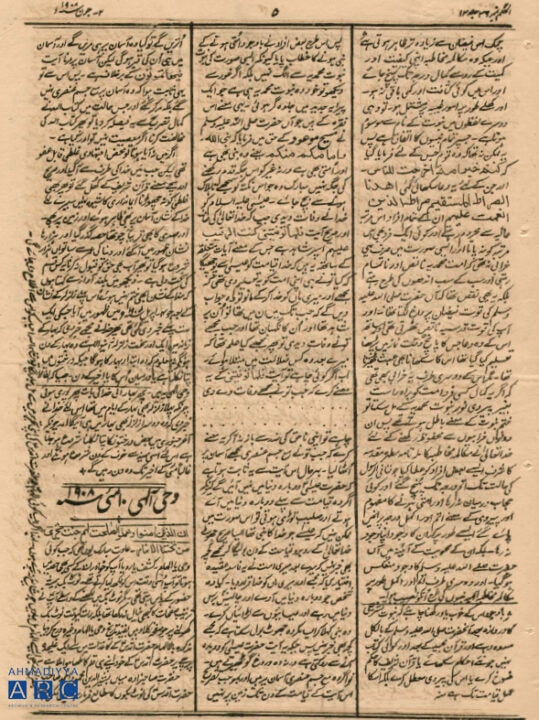
“A divine revelation; 10 May 1908:
اِنَّ الَّذِيْنَ اٰمَنُوْا وَعَمِلُوا الصَّالِحَاتِ لَهُمْ جَنّٰتٌ تَجْرِیْ مِنْ تَحْتِهَا الْاَنْهَارُ
“[‘Surely, those who believe and do good works, for them are Gardens through which streams flow.’]
“It was the blessed routine [of the Promised Messiahas] that when he would receive a wahi [revelation], vision or dream, no matter if it happened at any time of the night, he would note it down immediately. He always had a notebook with him. But while noting down [the revelations] in the notebook, he had never followed the sequence of pages and while opening the notebook during the night, whichever page would open first, he would note the revelation along with its date.
“The above-mentioned revelation has been found from the papers of the Promised Messiahas, which was noted down on a separate paper with his own pen.
“Hazrat Sahibzada Mian Bashiruddin Mahmud Ahmad Sahib[ra] is [nowadays] reading the notebooks of Hazrat Aqdasas. It is possible that there could be some more revelations that have not yet been published. Therefore, if any such revelation is found from the Promised Messiah’sas own writing, then, insha-Allah, members will be informed in this regard.” (Al Hakam [Urdu], 2 June 1908, p. 5)
The aforementioned revelation can be found in Tadhkirah (English) at page 1,033.
Revelation during a rail journey
Hazrat Mufti Muhammad Sadiqra, while mentioning an incident of 1891, when he accompanied the Promised Messiahas in a rail journey from Ludhiana to Amritsar, stated:
“Once, while sitting in the train carriage, the Promised Messiahas said that he had just received a revelation. I do not remember what those words were. All we saw was that Huzoor’sas eyes were closed and we thought that perhaps he was feeling drowsy.” (Zikr-e-Habib, p. 13)
Revelations being revealed more than once
Some revelations were revealed to him many times in the same wording. Hazrat Mufti Sahibra states that in this regard, Huzooras used to say:
“The revelations which are revealed again and again have a distinct glory each time. For example, the revelation:
اِنِّیْ مُهِيْنٌ مَّنْ اَرَادَ اِهَانَتَكَ
“[‘I shall humiliate him who seeks to humiliate you’] has been revealed many times and each time, it has manifested in a unique way.” (Zikr-e-Habib, p. 151)
Gap between revelations
Hazrat Mufti Sahibra states at another instance that the Promised Messiahas used to say:
“On some days, I receive several revelations, one after the other and with great intensity, and a series of revelations initiates, while on other days, there is such silence [in terms of receiving revelations] that I begin to reflect over the cause for such a silence.
“There came a time during the life of the Holy Prophetsa when people assumed that divine discourse had seen its cessation. Thereupon, the disbelievers started mocking by saying, ‘Now God is angry with Muhammad[sa].’ God Almighty then responded to this in the Holy Quran as:
وَ الضُّحٰی۔ وَ الَّيۡلِ اِذَا سَجٰی۔ مَا وَدَّعَكَ رَبُّكَ وَ مَا قَلٰی
“By the growing brightness of the forenoon, and [by] the night when it becomes still, Thy Lord has not forsaken thee, nor is He displeased [with thee].” [Surah al-Duha, Ch.93, V.2-4]
“This means that although day rises and is followed by night automatically, and then after that, the light of day emerges again, it has nothing to do with the pleasure or anger of God Almighty. Neither does the rise of a day mean that God Almighty is pleased with His servants, nor does the coming of night mean that God Almighty is angry with His servants.
“In fact, by witnessing this interchange, every wise person can understand that this is in accordance with the fixed laws of God Almighty and this is His sunnah, that night comes after day and day rises following nightfall.” (Zikr-e-Habib, pp. 163-164)
Publication of Huzoor’s revelations and visions
Most of his revelations and visions were published during his lifetime in his diaries, books, announcements and through newspapers and magazines.
When Jamaat-e-Ahmadiyya’s first ever newspaper, Al Hakam (Urdu) was launched, it served greatly in recording Huzoor’sas revelations and visions on a regular basis. Through Al Hakam, the latest revelations of the Promised Messiahas got published instantaneously.
Then the newspaper Badr joined in sharing the sacred responsibility of publicising the blessed revelations Huzooras would receive.
Hazrat Mufti Muhammad Sadiqra states that the Promised Messiahas used to say:
“These newspapers, Al Hakam and Badr, are my two ‘arms’. They immediately publish the revelations to [other] countries and become witnesses.” (Zikr-e-Habib, p. 151)
Both of these newspapers rendered great services in those early days and served to spread Huzoor’sas revelations and visions to members of the Jamaat and opponents as well.
Regarding the revelations and divine visions of 1898, Hazrat Sheikh Yaqub Ali Irfanira states:
“In 1898, he [the Promised Messiahas] continued to experience revelations, divine visions and dreams from the Almighty Allah and all those revelations and divine visions comprised of glad tidings and warnings in the form of prophecies. In most of those revelations, future incidents were foretold in regard to him [Huzooras] and his Jamaat […]
“It is among the many blessings of Allah the Almighty on me that I had published those revealed glad tidings, after hearing them directly from Hazrat [the Promised Messiahas], in Al Hakam generally and some in Maktubat-e-Ahmadiyya. For this, all praise belongs to Allah!” (Hayat-e-Ahmad, Vol. 5, Part 1, pp. 205-206)
Al Hakam (Urdu) published a letter of Hazrat Mufti Muhammad Sadiqra, in which he appreciated Al Hakam’s services in spreading the Promised Messiah’sas message.
In that letter, Hazrat Mufti Sahibra said that many great tasks were being accomplished through this useful paper, including showing the world miracles and wonders by publishing the revelations of the Promised Messiahas and by conveying his pure sayings to people living in distant lands. (Al Hakam [Urdu], 17 September 1902, pp. 6-7)
Hazrat Sheikh Yaqub Ali Irfanira (Editor Al Hakam) and Hazrat Mufti Muhammad Sadiqra (Editor Badr) would ask Huzooras regarding new revelations so they could be published in these newspapers. Then, the Promised Messiahas would inform them about the new revelations and they would write back to Huzooras for final checking of those revelations, before the publication.
We find a similar kind of letter, dated 5 June 1906, by Hazrat Mufti Muhammad Sadiqra, in which he requested Huzooras, “The final draft of the newspaper will be prepared today [5 June 1906]. If there is any new revelation, please do inform.”
In that letter, he also referenced two visions of Huzooras, which he had been told previously, for seeking the final approval for publication.

In reply, Huzooras wrote his latest revelations of 5 June 1906, at the bottom right of the same letter, which were as follows:
مَآاُرْسِلَ نَبِيٌّ اِلَّا اَخْزیٰ بِهِ اللّٰهُ قَوْماً لَّا يُؤْمِنُوْنَ
“No prophet has been sent, except that Allah has humiliated on his account those who do not believe.” (Tadhkirah [English], pp. 860; Badr, 7 June 1906; Al Hakam, 10 June 1906)
يُلْقِی الرُّوْحَ عَلٰی مَنْ يَّشَآءُ مِنْ عِبَادِهٖ
“God sends down His Spirit of prophethood on whomsoever He wills from among His servants.” (Tadhkirah [English], pp. 860-861; Al Hakam, 10 June 1906)
خدا کی فیلنگ اور خدا کی مُہر نے کتنا بڑا کام کیا
“What a high design has been accomplished by God’s feeling and His Seal.” (Tadhkirah [English], pp. 860-861; Al Hakam, 10 June 1906)
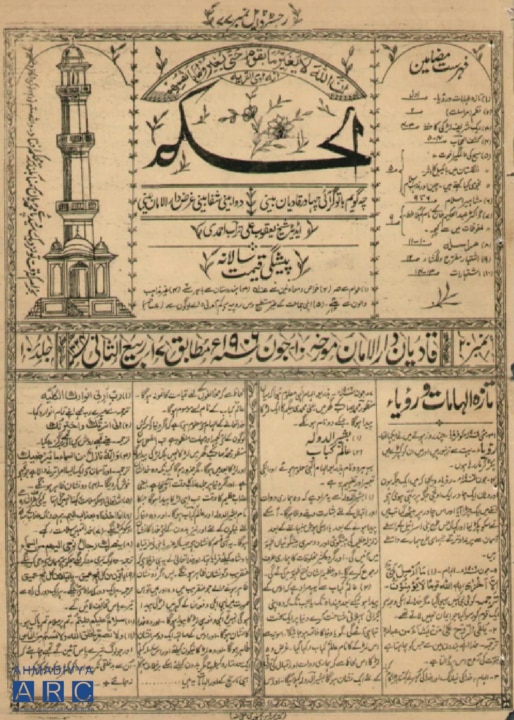
Then, we find another paper which has a revelation written on it, in Huzoor’sas own handwriting. It includes the revealed words:
اِنِّیْ مَعَكَ يَا مَسْرُوْرُ
“Surely, I am with you, O Masroor [happy one].” (Tadhkirah [English], p. 1016)
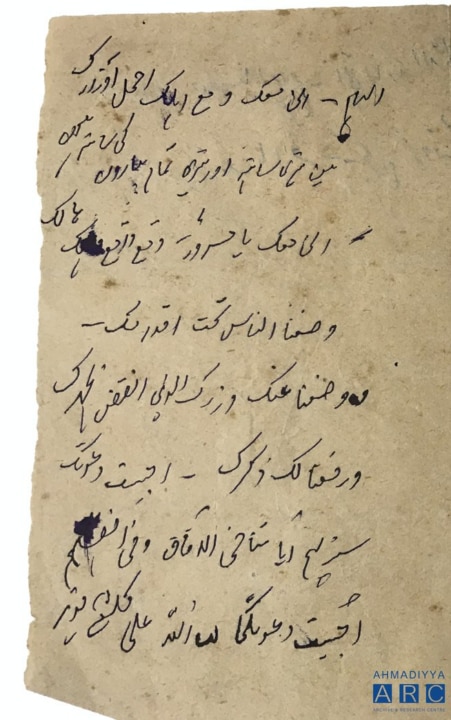
Compilation of Tadhkirah
The compilation of the revelations and visions of the Promised Messiahas took place during the time of Hazrat Musleh-e-Maudra and it was published in 1935, under the title of “Tadhkirah”.
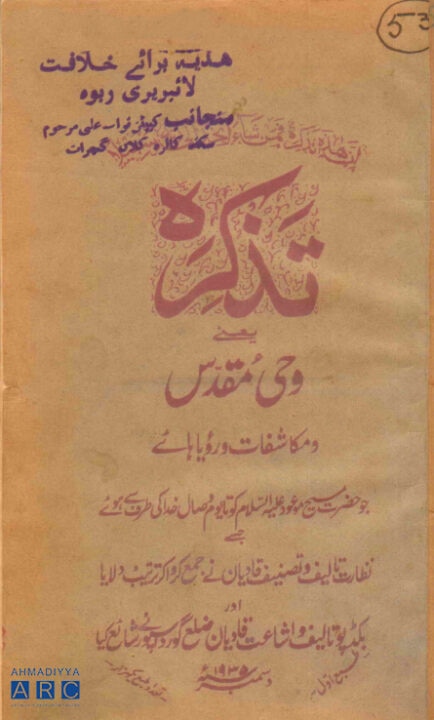
In 1938, Hazrat Musleh-e-Maudra found another notebook of the Promised Messiahas, which included his revelations and visions, dated between 17 August and 21 December 1894. It included the revelation “Daagh-e-Hijrat” (“The stigma of migration”) under the date of 18 September 1894.
Hazrat Musleh-e-Maudra mentioned this notebook in his Friday Sermon of 19 August 1938. He stated that as per his knowledge, those revelations were not yet published. (Al Fazl, 31 August 1938)
When the fourth edition of Tadhkirah was scheduled to be published, Hazrat Khalifatul Masih IVrh instructed Nazarat-e-Ishaat to include the revelations present in the above-mentioned notebook. The revelations of this notebook can be found in Tadhkirah (English) from pages 336-349.

